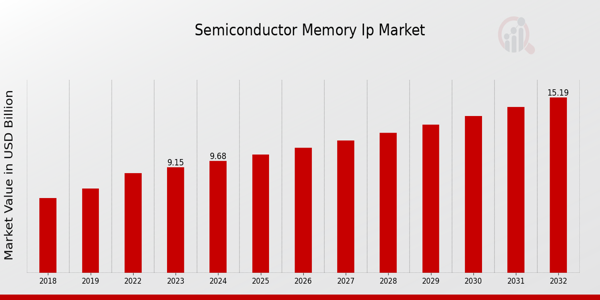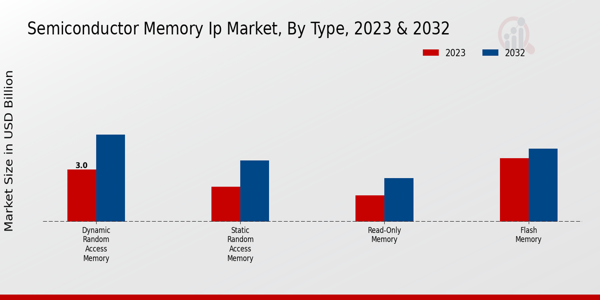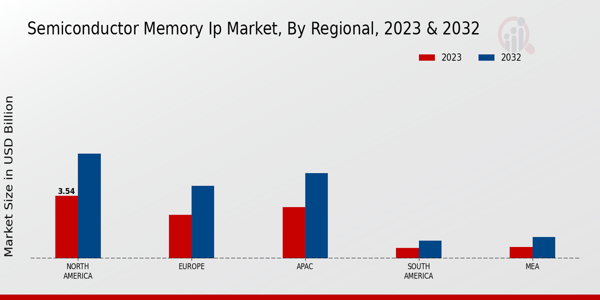Global Semiconductor Memory IP Market Overview
The Semiconductor Memory IP Market Size was estimated at 8.65 (USD Billion) in 2022. The Semiconductor Memory IP Market Industry is expected to grow from 9.15(USD Billion) in 2023 to 15.2 (USD Billion) by 2032. The Semiconductor Memory IP Market CAGR (growth rate) is expected to be around 5.8% during the forecast period (2024 - 2032).
Key Semiconductor Memory IP Market Trends Highlighted
The Semiconductor Memory IP Market is experiencing significant growth driven by the increasing demand for advanced electronics, such as smartphones, tablets, and other smart devices. The rapid advancement of technologies like artificial intelligence, machine learning, and the Internet of Things is creating a need for more efficient memory solutions. Additionally, the rise in data generation leads to greater storage requirements, pushing manufacturers to invest in innovative memory technologies. As digitalization continues to seep into various industries, the need for high-performance memory solutions is becoming increasingly evident.
Opportunities in this market are abundant, particularly for companies that can develop memory IP cores that cater to specialized applications, such as automotive electronics and edge computing.The trend toward high bandwidth and low latency is opening doors for new entrants and established players alike to capture niche markets. By focusing on energy-efficient memory solutions, players can also meet the growing demand for sustainability in technology products. Collaborations and partnerships among tech companies may also yield advancements and foster innovation, helping to shape the future landscape of the semiconductor memory sector.
In recent times, there has been a noticeable shift toward integrating more advanced functionalities within memory IP, such as error correction and security features. This trend reflects the industry's response to the burgeoning requirements for data protection and reliability.Additionally, the growing emphasis on system-on-chip designs is driving the demand for customizable memory solutions that can meet varying specifications. Overall, the landscape of the semiconductor memory IP market is dynamic, with ongoing innovations and developments set to redefine how memory technologies support a vast array of applications across many sectors.

Source: Primary Research, Secondary Research, MRFR Database and Analyst Review
Semiconductor Memory IP Market Drivers
Growing Demand for High-Performance Computing
The rapid evolution and increasing demand for high-performance computing applications are significantly driving the Semiconductor Memory IP Market Industry. With advancements in technology, applications such as artificial intelligence, big data analytics and cloud computing are becoming more prevalent. These applications require efficient and high-speed memory solutions to manage huge volumes of data.
As industries push for faster processing capabilities and enhanced data management solutions, the demand for advanced semiconductor memory IP becomes apparent.This trend is further propelled by the growth of sectors like telecommunications and enterprise computing, where the need for extensive data handling and rapid retrieval systems has never been more critical. The semiconductor memory IP is at the core of providing the necessary performance upgrades required by these applications. As enterprises embrace digital transformation, investments in upgraded memory technologies become essential.
The need to maintain competitive advantages through technological advancements will prompt greater investment in semiconductor memory IP, therefore driving market growth in the coming years.In addition, the growing use of mobile computing devices necessitates the use of high-density memory solutions, which adds to the expansion of the Semiconductor Memory IP Market Industry as well.
Rise in IoT and Smart Devices
The proliferation of Internet of Things (IoT) devices and the increasing adoption of smart technologies are vital drivers in the Semiconductor Memory IP Market Industry. As IoT applications expand across various sectors, the demand for efficient memory solutions to support these devices intensifies. Smart devices require memory that is not only fast but also energy-efficient to handle the continuous exchange of data. This increasing necessity for enhanced memory solutions in consumer electronics, automotive applications, and industrial automation is set to create a significant impact on the market.
Advancements in Memory Technology
Continuous advancements in memory technology are driving the Semiconductor Memory IP Market Industry forward. Innovations such as 3D NAND, MRAM, and emerging non-volatile memory types are enhancing memory capabilities and performance metrics. These advancements provide opportunities for semiconductor memory IP to deliver better speed and efficiency, which is crucial for modern applications. The race for more powerful and efficient memory solutions is motivating companies to invest heavily in R, thereby fostering market growth.
Semiconductor Memory IP Market Segment Insights
Semiconductor Memory IP Market Type Insights
The Semiconductor Memory IP Market is a significant component of the broader electronics landscape, and its segmentation by type reveals crucial insights into its valuation and growth potential. In 2023, the total revenue of the market is valued at 9.15 USD Billion, showcasing its robust demand as the industry advances in technological capabilities. Dynamic Random Access Memory (DRAM) holds a majority share in this market segment, valued at 3.0 USD Billion for the year, emphasizing its essential role in high-performance computing and mobile applications. DRAM's performance benefits have led it to dominate sectors such as data centers and consumer electronics.
Following closely is Static Random Access Memory (SRAM), valued at 2.0 USD Billion in 2023; its significance lies in its speed and low power consumption, making it vital for applications requiring rapid access and real-time processing, particularly in networking and caching.
The Read-Only Memory (ROM) segment, though smaller, is valued at 1.5 USD Billion, reflecting its importance in storing firmware and applications that do not require frequent updates, highlighting a steady demand in embedded systems. Flash Memory, with a valuation of 3.65 USD Billion in 2023, serves as a critical driver in mobile devices and solid-state drives, influencing the market's landscape significantly due to the booming demand for these technologies in data storage solutions. The combination of these types illustrates a diverse ecosystem where each type fulfills specific performance profiling, and customer needs in the evolving semiconductor memory space.
With the market projected to expand significantly by 2032, the segments within the Semiconductor Memory IP Market reveal not only trends in technology adoption and innovation but also an increasing reliance on specialized memory solutions across multiple industries, driving both growth and competition in the Semiconductor Memory IP Market industry. As the industry continues to evolve, it presents opportunities for advancements in semiconductor materials and designs, with each type adapting to meet the demands of emerging technologies, thereby shaping the future of memory solutions based on distinct market statistics and consumption patterns.

Source: Primary Research, Secondary Research, MRFR Database and Analyst Review
Semiconductor Memory IP Market Technology Insights
The market growth is fueled by the increasing demand for data storage solutions and advancements in technology, leading to enhanced performance of memory components. Within this landscape, DRAM technology plays a vital role, primarily utilized in computing and consumer electronics, while SRAM is essential for high-speed processing tasks in various applications.NAND memory holds significant importance due to its dominance in mobile devices and solid-state drives, reflecting the industry's shift toward faster storage solutions. NOR flash memory, although smaller in market share, is critical for embedded applications where quick read access is necessary.
This diversification in technology applications contributes to the overall dynamics of the Semiconductor Memory IP Market, creating opportunities for innovations and improvements in memory technologies.
Semiconductor Memory IP Market Application Insights
The Automotive sector, with its growing demand for advanced driver assistance systems and electric vehicles, plays a crucial role in driving innovation and, subsequently, the need for efficient semiconductor memory solutions. Similarly, the Consumer Electronics segment is noteworthy, as the rise in smart devices and IoT applications creates a steady demand for high-performance memory IP. The Telecommunications sector remains vital due to the surge in data traffic and the expansion of 5G technology, necessitating enhancements in memory capacity and speed.The Industrial segment also secures a notable position as automation and smart factory trends necessitate robust and reliable memory solutions.
Overall, the market's growth trajectory is shaped by these applications, each addressing innovative requirements and contributing to the overall Semiconductor Memory IP Market revenue. Additionally, trends such as digital transformation and increased automation within various industries offer numerous opportunities for expansion within this market, emphasizing its importance in the current technological landscape.
Semiconductor Memory IP Market End Use Insights
The Semiconductor Memory IP Market has shown considerable growth prospects in the End Use segment, with applications broadly categorized into Personal Use, Commercial Use and Military Use. Within the Personal Use category, the prevalence of consumer electronics and the rise of smart devices contribute significantly to market demand, representing a vast user base.
The Commercial Use segment is also substantial, driven by advancements in data centers and enterprise-level applications, which require robust memory solutions for efficient data handling.Meanwhile, the Military Use segment is crucial, as cutting-edge technologies and security requirements demand specialized memory solutions, often leading to higher investments and innovation in this area. The diverse Semiconductor Memory IP Market segmentation highlights the potential for growth driven by technological advancements, changing consumer behaviors, and the increasing necessity for high-performance memory solutions across industries.
As the market evolves, these segments are poised to adapt to emerging trends, with various challenges and opportunities shaping their trajectories in the coming years.
Semiconductor Memory IP Market Regional Insights
The Semiconductor Memory IP Market is experiencing significant growth across various regions, reflecting diverse market dynamics and opportunities. In 2023, North America leads the market with a valuation of 3.54 USD Billion, showcasing a significant influence in the semiconductor industry. Europe follows closely with a valuation of 2.45 USD Billion, driven by advancements in automotive and communication sectors.
The APAC region, valued at 2.9 USD Billion, is noteworthy for its vast consumer electronics market, making it a crucial area for innovation.South America and MEA, valued at 0.6 USD Billion and 0.66 USD Billion, respectively, represent emerging regions with potential growth, particularly in industrial applications. As these segments contribute increasingly to the overall Semiconductor Memory IP Market revenue, they reveal a landscape shaped by technology advancements, rising demand for memory solutions, and the strategic positioning of semiconductor firms for market growth in the coming years.
The dominance of North America underscores its pivotal role in supporting R efforts and sustaining technological leadership within the industry, while the APAC region's rapid expansion in electronics positions it as a strong competitor.

Source: Primary Research, Secondary Research, MRFR Database and Analyst Review
Semiconductor Memory IP Market Key Players and Competitive Insights
The Semiconductor Memory IP Market is an expansive and rapidly evolving sector that serves as a critical foundation for various electronic applications and innovations. With the increasing demand for memory solutions across diverse industries such as consumer electronics, automotive, telecommunications, and computing, the competitive landscape has become increasingly dynamic. Numerous players are striving to secure market share by enhancing their technology offerings, developing advanced intellectual property, and establishing strategic partnerships. Competition intensifies with an ongoing push toward miniaturization, higher performance metrics, and the integration of emerging technologies such as artificial intelligence and machine learning into memory systems.
Companies focus on research and development to cater to the demand for innovative memory solutions that can facilitate improved data storage and processing capabilities. The ability to provide proprietary memory IP that is both efficient and reliable has become a key differentiator among market participants, driving the need to adapt quickly to changing consumer demands and technological advancements.STMicroelectronics holds a prominent position within the Semiconductor Memory IP Market, leveraging its significant technical expertise and extensive portfolio of products.
The company's strengths lie in its deep-rooted experience in semiconductor technology, which allows it to develop a wide range of memory IP solutions that cater to both consumer and industrial applications. STMicroelectronics has established its reputation through consistent innovation, high-quality design, and a commitment to meeting the needs of diverse markets. Its dedication to research and development ensures that the company remains ahead of technological trends, allowing for the timely introduction of cutting-edge memory IP solutions.
Furthermore, STMicroelectronics benefits from a well-integrated supply chain and strong customer relationships, providing it with a competitive edge that enhances its market presence and reputation within the memory IP domain.Analog Devices excels in delivering high-performance memory IP solutions, contributing significantly to the Semiconductor Memory IP Market. With a focus on precision and reliability, Analog Devices has developed a range of products that are highly regarded for their superior performance in challenging applications.
The company’s strengths are evident in its extensive technological know-how, which allows it to create innovative memory solutions that address the specific needs of various industries, including automotive, healthcare, and communications. With a commitment to advancing technology, Analog Devices invests heavily in research and development, which facilitates the ongoing enhancement of its memory IP offerings. This comprehensive approach not only solidifies Analog Devices' position within the market but also ensures it remains competitive amidst the rapidly shifting landscape of semiconductor technology. The company’s emphasis on customer collaboration further enhances its capability to meet evolving market demands effectively.
Key Companies in the Semiconductor Memory IP Market Include
Semiconductor Memory IP Market Industry Developments
Recent developments in the Semiconductor Memory IP Market have highlighted significant activity among key players, including STMicroelectronics, Analog Devices, and Micron Technology, focusing on innovations in-memory solutions to meet rising data demands. Current affairs indicate a surge in market valuation, with companies like Samsung Electronics and SK Hynix capitalizing on advancements in-memory technologies. There has been notable merger and acquisition activity, particularly with companies such as Qualcomm and NXP Semiconductors seeking to enhance their IP portfolios through strategic collaborations. Intel and Broadcom are also pursuing partnerships to solidify their positions.
Growth patterns indicate a shift toward high-performance memory applications, fostering competitive advancements among Infineon Technologies and Marvell Technology. These dynamics are influencing the pricing and availability of semiconductor memory IP products, reflecting increased demand in sectors such as automotive and consumer electronics. As companies adapt to technological shifts, investments in research and development are ramping up, further positioning the market for continuous growth. The strategic moves by these leading firms underscore their commitment to maintaining competitive advantages and responding to emerging market needs.
Semiconductor Memory IP Market Segmentation Insights
Semiconductor Memory IP Market Type Outlook
- Dynamic Random Access Memory
- Static Random Access Memory
Semiconductor Memory IP Market Technology Outlook
Semiconductor Memory IP Market Application Outlook
Semiconductor Memory IP Market End Use Outlook
Semiconductor Memory IP Market Regional Outlook
|
Report Attribute/Metric
|
Details
|
|
Market Size 2022
|
8.65(USD Billion)
|
|
Market Size 2023
|
9.15(USD Billion)
|
|
Market Size 2032
|
15.2(USD Billion)
|
|
Compound Annual Growth Rate (CAGR)
|
5.8% (2024 - 2032)
|
|
Report Coverage
|
Revenue Forecast, Competitive Landscape, Growth Factors, and Trends
|
|
Base Year
|
2023
|
|
Market Forecast Period
|
2024 - 2032
|
|
Historical Data
|
2019 - 2023
|
|
Market Forecast Units
|
USD Billion
|
|
Key Companies Profiled
|
STMicroelectronics, Analog Devices, Infineon Technologies, Marvell Technology, Cirrus Logic, Qualcomm, Intel, Samsung Electronics, Texas Instruments, SK Hynix, NXP Semiconductors, Western Digital, Micron Technology, Broadcom, Renesas Electronics
|
|
Segments Covered
|
Type, Technology, Application, End Use, Regional
|
|
Key Market Opportunities
|
Growing demand for AI applications,
Expansion in IoT devices,
Increasing use in automotive electronics,
Rising need for data centers,
Advancements in 5G technology
|
|
Key Market Dynamics
|
Rapid technological advancements,
Increasing demand for data storage,
Growing IoT applications,
Rising focus on energy efficiency,
Market consolidation and partnerships
|
|
Countries Covered
|
North America, Europe, APAC, South America, MEA
|
Semiconductor Memory IP Market Highlights:
Frequently Asked Questions (FAQ):
The Semiconductor Memory IP Market is expected to be valued at 15.2 USD Billion by 2032.
The expected CAGR for the Semiconductor Memory IP Market from 2024 to 2032 is 5.8%.
North America is projected to be the largest market region, valued at 5.9 USD Billion by 2032.
The market size for Dynamic Random Access Memory is expected to reach 5.0 USD Billion by 2032.
Key players in the market include STMicroelectronics, Analog Devices, Infineon Technologies, and Qualcomm.
The market size for Static Random Access Memory is projected to reach 3.5 USD Billion by 2032.
The Flash Memory segment is expected to be valued at 4.2 USD Billion by 2032.
The Semiconductor Memory IP Market in Europe is projected to be valued at 4.1 USD Billion by 2032.
The Read-Only Memory segment is expected to have a market value of 2.5 USD Billion by 2032.
South America is forecasted to grow to 1.0 USD Billion by 2032 in the Semiconductor Memory IP Market.














